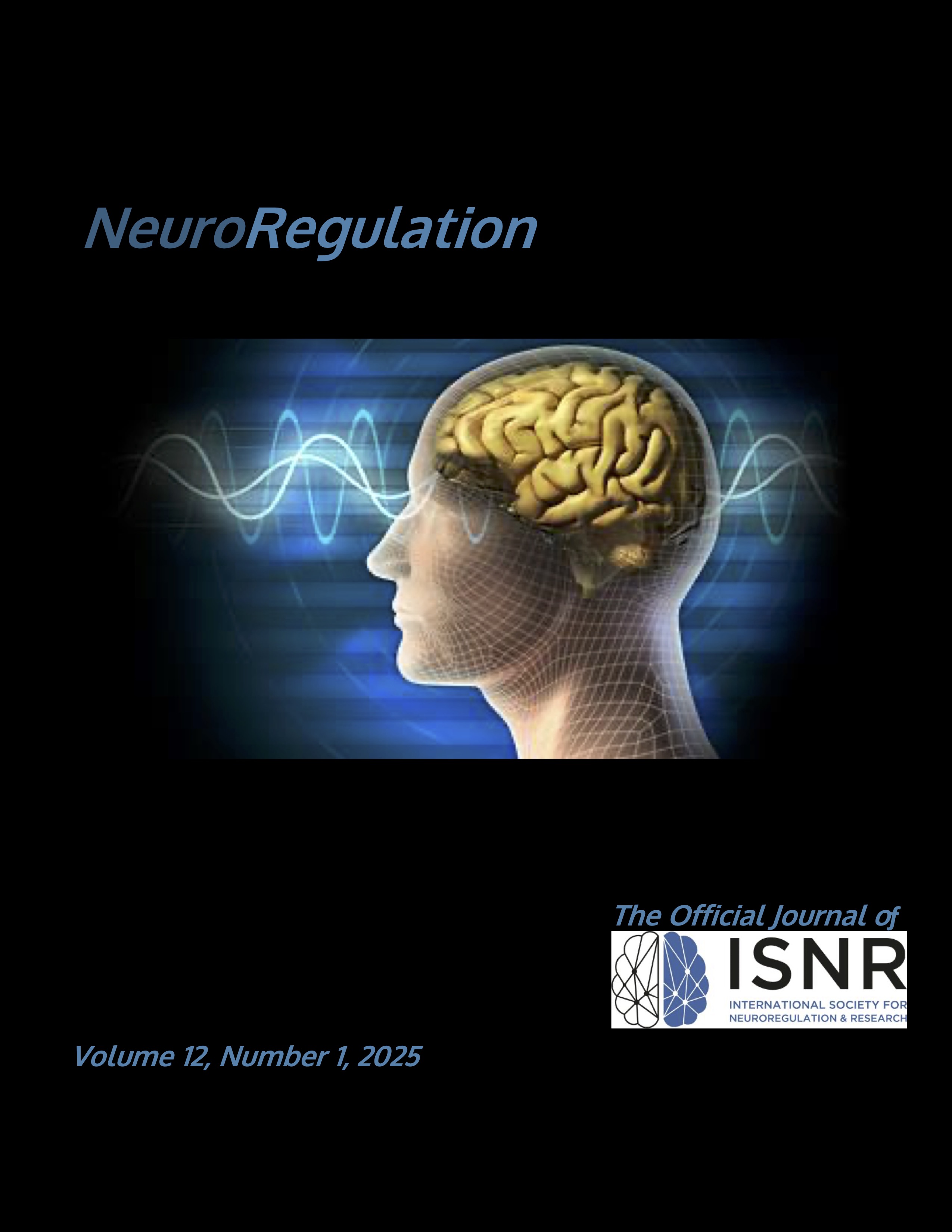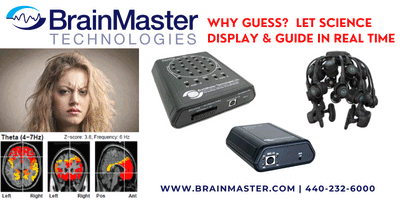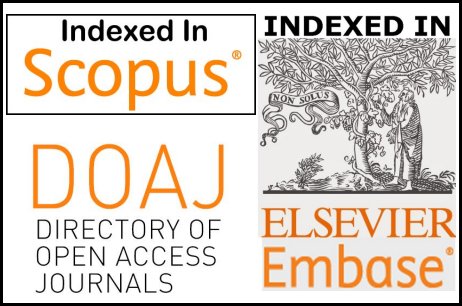Effectiveness of Brain-Computer Interface (BCI)-Based Attention Training Game System for Symptom Reduction, Behavioral Enhancement, and Brain Function Modulation in Children With ADHD: A Systematic Review and Single-Arm Meta-Analysis
DOI:
https://doi.org/10.15540/nr.12.1.51Keywords:
Attention-deficit/hyperactivity disorder (ADHD), Brain-Computer Interface, Gaming, NeurofeedbackAbstract
Introduction. Brain-computer interface (BCI)-based games have been developed as an adjunct to conventional ADHD therapy. This review aims to assess the effectiveness of these systems. Methodology. ADHD Rating Scale (ADHD-RS) and Integrated Visual and Auditory Continuous Performance Test (IVA-CPT) scores were analyzed, while other outcomes were assessed qualitatively. Results. Eleven studies with a total of 421 subjects were included, which utilized seven unique BCI-based games. There was a significant reduction in parent-reported (MD = 2.20; 95% CI: 0.91–3.49) and clinician-reported (MD = 1.60; 95% CI: 0.32–2.88) inattention (IA) scores in the intervention group versus control. There was a statistically significant reduction in parent-reported (MD = 3.70; 95% CI: 2.11–5.29) and clinician-reported (MD = 3.20; 95% CI: 1.82–4.58) IA scores and parent-reported hyperactive/impulsivity (HI) scores (MD = 3.88; 95% CI: 1.88–5.87) in a pre–post intervention analysis. IVA-CPT visual and auditory scores showed a statistically significant increase in the response control (MD = 12.85; 95% CI: 6.01–19.68) and attention (MD = 22.93; 95% CI: 15.44–30.43) quotients. Three studies reported a statistically significant reduction in Child Behavior Checklist (CBCL) scores. One study found a significant change in small-worldness over time (P = .045), indicating altered brain network structure after BCI-based attention training. Conclusion. BCI-based interventions show promise in controlling inattentive, hyperactive-impulsive, behavioral, and learning disability symptoms of ADHD, but further research is needed on a more holistic approach targeting both inattention and learning symptoms simultaneously.
References
Abarbanel, A. (1999). The neural underpinnings of neurofeedback training. In J. R. Evans & A. Abarbanel (Eds.), Introduction to quantitative EEG and neurofeedback (pp. 311–340). Academic Press. https://doi.org/10.1016/B978-012243790-8/50013-4
Adamou, M., Fullen, T., & Jones, S. L. (2020). EEG for diagnosis of adult ADHD: A systematic review with narrative analysis. Frontiers in Psychiatry, 11, Article 871. https://doi.org/10.3389/fpsyt.2020.00871
Al-Yagon, M., Forte, D., & Avrahami, L. (2020). Executive functions and attachment relationships in children with ADHD: Links to externalizing/internalizing problems, social skills, and negative mood regulation. Journal of Attention Disorders, 24(13), 1876–1890. https://doi.org/10.1177/1087054717730608
Arns, M., De Ridder, S., Strehl, U., Breteler, M., & Coenen, A. (2009). Efficacy of neurofeedback treatment in ADHD: The effects on inattention, impulsivity and hyperactivity: A meta-analysis. Clinical EEG and Neuroscience, 40(3), 180–189. https://doi.org/10.1177/155005940904000311
Ayano, G., Yohannes, K., & Abraha, M. (2020). Epidemiology of attention-deficit/hyperactivity disorder (ADHD) in children and adolescents in Africa: A systematic review and meta-analysis. Annals of General Psychiatry, 19(1), Article 21. https://doi.org/10.1186/s12991-020-00271-w
Bassett, D. S., & Bullmore, E. T. (2017). Small-world brain networks revisited. The Neuroscientist, 23(5), 499–516. https://doi.org/10.1177/1073858416667720
Berk, M., Ng, F., Dodd, S., Callaly, T., Campbell, S., Bernardo, M., & Trauer, T. (2008). The validity of the CGI severity and improvement scales as measures of clinical effectiveness suitable for routine clinical use. Journal of Evaluation in Clinical Practice, 14(6), 979–983. https://doi.org/10.1111/j.1365-2753.2007.00921.x
Blandón, D. Z., Muñoz, J. E., Lopez, D. S., & Gallo, O. H. (2016). Influence of a BCI neurofeedback videogame in children with ADHD. Quantifying the brain activity through an EEG signal processing dedicated toolbox. 2016 IEEE 11th Colombian Computing Conference (CCC), 1–8. https://doi.org/10.1109/ColumbianCC.2016.7750788
Bronte-Stewart, H. M., Petrucci, M. N., O’Day, J. J., Afzal, M. F., Parker, J. E., Kehnemouyi, Y. M., Wilkins, K. B., Orthlieb, G. C., & Hoffman, S. L. (2020). Perspective: Evolution of control variables and policies for closed-loop deep brain stimulation for Parkinson’s disease using bidirectional deep-brain-computer interfaces. Frontiers in Human Neuroscience, 14, Article 353. https://doi.org/10.3389/fnhum.2020.00353
Carlson, C. L., Shin, M., & Booth, J. (1999). The case for DSM-IV subtypes in ADHD. Mental Retardation and Developmental Disabilities Research Reviews, 5(3), 199–206. https://doi.org/10.1002/(SICI)1098-2779(1999)5:3<199::AID-MRDD6>3.0.CO;2-#
Castellanos, F. X., & Proal, E. (2012). Large-scale brain systems in ADHD: Beyond the prefrontal-striatal model. Trends in Cognitive Sciences, 16(1), 17–26. https://doi.org/10.1016/j.tics.2011.11.007
Cervantes, J.-A., López, S., Cervantes, S., Hernández, A., & Duarte, H. (2023). Social robots and brain–computer interface video games for dealing with attention deficit hyperactivity disorder: A systematic review. Brain Sciences, 13(8), Article 8. https://doi.org/10.3390/brainsci13081172
Cubillo, A., Halari, R., Smith, A., Taylor, E., & Rubia, K. (2012). A review of fronto-striatal and fronto-cortical brain abnormalities in children and adults with attention deficit hyperactivity disorder (ADHD) and new evidence for dysfunction in adults with ADHD during motivation and attention. Cortex, 48(2), 194–215. https://doi.org/10.1016/j.cortex.2011.04.007
DuPaul, G. J., Power, T. J., Anastopoulos, A. D., & Reid, R. (1998). ADHD Rating Scale—IV: Checklists, norms, and clinical interpretation (pp. viii, 79). The Guilford Press.
DuPaul, G. J., & Volpe, R. J. (2009). ADHD and learning disabilities: Research findings and clinical implications. Current Attention Disorders Reports, 1(4), 152–155. https://doi.org/10.1007/s12618-009-0021-4
Enriquez-Geppert, S., Smit, D., Pimenta, M. G., & Arns, M. (2019). Neurofeedback as a treatment intervention in ADHD: Current evidence and practice. Current Psychiatry Reports, 21(6), Article 46. https://doi.org/10.1007/s11920-019-1021-4
Georgiou, E., Thanos, K.-G., Kanellos, T., Doulgerakis, A., & Thomopoulos, S. (2019). Evaluating the relation between the EEG brainwaves and attention measures, and the children’s performance in REEFOCUS game designed for ADHD symptoms improvement. In B. M. Cullum, D. Kiehl, & E. S. McLamore (Eds.), Smart Biomedical and Physiological Sensor Technology XVI, Proceedings Volume 11020. PIE Defense + Commercial Sensing. Baltimore, MD, USA. https://doi.org/10.1117/12.2518901
Gummadavelli, A., Zaveri, H. P., Spencer, D. D., & Gerrard, J. L. (2018). Expanding brain–computer interfaces for controlling epilepsy networks: Novel thalamic responsive neurostimulation in refractory epilepsy. Frontiers in Neuroscience, 12, Article 474. https://doi.org/10.3389/fnins.2018.00474
Higgins, J. P. T., Altman, D. G., Gøtzsche, P. C., Jüni, P., Moher, D., Oxman, A. D., Savović, J., Schulz, K. F., Weeks, L., & Sterne, J. A. C. (2011). The Cochrane Collaboration’s tool for assessing risk of bias in randomised trials. BMJ, 343, Article d5928. https://doi.org/10.1136/bmj.d5928
Homack, S., & Riccio, C. A. (2006). Conners’ Continuous Performance Test (2nd ed.; CCPT-II). Journal of Attention Disorders, 9(3), 556–558. https://doi.org/10.1177/1087054705283578
Jensen, C. M., Amdisen, B. L., Jørgensen, K. J., & Arnfred, S. M. H. (2016). Cognitive behavioural therapy for ADHD in adults: Systematic review and meta-analyses. ADHD Attention Deficit and Hyperactivity Disorders, 8(1), 3–11. https://doi.org/10.1007/s12402-016-0188-3
Johnstone, S. J., Roodenrys, S. J., Johnson, K., Bonfield, R., & Bennett, S. J. (2017). Game-based combined cognitive and neurofeedback training using focus pocus reduces symptom severity in children with diagnosed AD/HD and subclinical AD/HD. International Journal of Psychophysiology, 116, 32–44. https://doi.org/10.1016/j.ijpsycho.2017.02.015
Konrad, K., & Eickhoff, S. B. (2010). Is the ADHD brain wired differently? A review on structural and functional connectivity in attention deficit hyperactivity disorder. Human Brain Mapping, 31(6), 904–916. https://doi.org/10.1002/hbm.21058
Kovacevic, N., Ritter, P., Tays, W., Moreno, S., & McIntosh, A. R. (2015). ‘My Virtual Dream’: Collective neurofeedback in an immersive art environment. PLoS ONE, 10(7), Article e0130129. https://doi.org/10.1371/journal.pone.0130129
Li, F., He, N., Li, Y., Chen, L., Huang, X., Lui, S., Guo, L., Kemp, G. J., & Gong, Q. (2014). Intrinsic brain abnormalities in attention deficit hyperactivity disorder: A resting-state functional MR imaging study. Radiology, 272(2), 514–523. https://doi.org/10.1148/radiol.14131622
Lim, C. G., Lee, T. S., Guan, C., Fung, D. S. S., Zhao, Y., Teng, S. S. W., Zhang, H., & Krishnan, K. R. R. (2012). A brain-computer interface based attention training program for treating attention deficit hyperactivity disorder. PLoS ONE, 7(10), Article e46692. https://doi.org/10.1371/journal.pone.0046692
Lim, C. G., Lee, T.-S., Guan, C., Sheng Fung, D. S., Cheung, Y. B., Teng, S. S. W., Zhang, H., & Krishnan, K. R. (2010). Effectiveness of a brain-computer interface based programme for the treatment of ADHD: A pilot study. Psychopharmacology Bulletin, 43(1), 73–82.
Lim, C. G., Poh, X. W. W., Fung, S. S. D., Guan, C., Bautista, D., Cheung, Y. B., Zhang, H., Yeo, S. N., Krishnan, R., & Lee, T. S. (2019). A randomized controlled trial of a brain-computer interface based attention training program for ADHD. PLoS ONE, 14(5), Article e0216225. https://doi.org/10.1371/journal.pone.0216225
Lim, C. G., Soh, C. P., Lim, S. S. Y., Fung, D. S. S., Guan, C., & Lee, T.-S. (2023). Home-based brain–computer interface attention training program for attention deficit hyperactivity disorder: A feasibility trial. Child and Adolescent Psychiatry and Mental Health, 17(1), Article 15. https://doi.org/10.1186/s13034-022-00539-x
Liu, T., Wang, J., Chen, Y., Wang, R., & Song, M. (2013). Neurofeedback treatment experimental study for ADHD by using the brain-computer interface neurofeedback system. In M. Long (Ed.), World congress on medical physics and biomedical engineering May 26–31, 2012, Beijing, China (pp. 1537–1540). Springer Berlin Heidelberg. https://doi.org/10.1007/978-3-642-29305-4_404
Marzbani, H., Marateb, H. R., & Mansourian, M. (2016). Neurofeedback: A comprehensive review on system design, methodology and clinical applications. Basic and Clinical Neuroscience, 7(2), 143–158. https://doi.org/10.15412/J.BCN.03070208
Mridha, M. F., Das, S. C., Kabir, M. M., Lima, A. A., Islam, Md. R., & Watanobe, Y. (2021). Brain-computer interface: Advancement and challenges. Sensors, 21(17), Article 5746. https://doi.org/10.3390/s21175746
Nøvik, T. S. (1999). Validity of the child behaviour checklist in a Norwegian sample. European Child & Adolescent Psychiatry, 8(4), 247–254. https://doi.org/10.1007/s007870050098
Park, K., Kihl, T., Park, S., Kim, M.-J., & Chang, J. (2019). Fairy tale directed game-based training system for children with ADHD using BCI and motion sensing technologies. Behaviour & Information Technology, 38(6), 564–577. https://doi.org/10.1080/0144929X.2018.1544276
Peñuelas-Calvo, I., Jiang-Lin, L. K., Girela-Serrano, B., Delgado-Gomez, D., Navarro-Jimenez, R., Baca-Garcia, E., & Porras-Segovia, A. (2022). Video games for the assessment and treatment of attention-deficit/hyperactivity disorder: A systematic review. European Child & Adolescent Psychiatry, 31(1), 5–20. https://doi.org/10.1007/s00787-020-01557-w
Pfiffner, L. J., & Haack, L. M. (2014). Behavior management for school-aged children with ADHD. Child and Adolescent Psychiatric Clinics of North America, 23(4), 731–746. https://doi.org/10.1016/j.chc.2014.05.014
Piña, R., Rozas, C., Contreras, D., Hardy, P., Ugarte, G., Zeise, M. L., Rojas, P., & Morales, B. (2020). Atomoxetine reestablishes long term potentiation in a mouse model of attention deficit/hyperactivity disorder. Neuroscience, 439, 268–274. https://doi.org/10.1016/j.neuroscience.2019.10.040
Purvis, K. L., & Tannock, R. (2000). Phonological processing, not inhibitory control, differentiates ADHD and reading disability. Journal of the American Academy of Child & Adolescent Psychiatry, 39(4), 485–494. https://doi.org/10.1097/00004583-200004000-00018
Qi, J., Li, B.-Z., Zhang, Y., Pan, B., Gao, Y.-H., Zhan, H., Liu, Y., Shao, Y.-C., Weng, X.-C., & Zhang, X. (2021). Disrupted small-world networks are associated with decreased vigilant attention after total sleep deprivation. Neuroscience, 471, 51–60. https://doi.org/10.1016/j.neuroscience.2021.07.010
Qian, X., Loo, B. R. Y., Castellanos, F. X., Liu, S., Koh, H. L., Poh, X. W. W., Krishnan, R., Fung, D., Chee, M. W., Guan, C., Lee, T.-S., Lim, C. G., & Zhou, J. (2018). Brain-computer-interface-based intervention re-normalizes brain functional network topology in children with attention deficit/hyperactivity disorder. Translational Psychiatry, 8(1), Article 149. https://doi.org/10.1038/s41398-018-0213-8
Raza, M. Z., Omais, M., Arshad, H. M. E., Maqsood, Musab, & Nadeem, A. A. (2024). Effectiveness of brain computer interface (BCI) based attention training game system for symptom reduction, behavioral enhancement, and brain function modulation in children with attention deficit hyperactivity disorder (ADHD): A systematic review. OSF Registries. https://doi.org/10.17605/OSF.IO/85HPT
Rozas, C., Carvallo, C., Contreras, D., Carreño, M., Ugarte, G., Delgado, R., Zeise, M. L., & Morales, B. (2015). Methylphenidate amplifies long-term potentiation in rat hippocampus CA1 area involving the insertion of AMPA receptors by activation of β-adrenergic and D1/D5 receptors. Neuropharmacology, 99, 15–27. https://doi.org/10.1016/j.neuropharm.2015.07.003
Sebastián-Romagosa, M., Cho, W., Ortner, R., Sieghartsleitner, S., Von Oertzen, T. J., Kamada, K., Laureys, S., Allison, B. Z., & Guger, C. (2023). Brain–computer interface treatment for gait rehabilitation in stroke patients. Frontiers in Neuroscience, 17, Article 1256077. https://doi.org/10.3389/fnins.2023.1256077
Shaffer, D. (1983). A Children’s Global Assessment Scale (CGAS). Archives of General Psychiatry, 40(11), Article 1228. https://doi.org/10.1001/archpsyc.1983.01790100074010
Sherman, E., Tan, J., & Hrabok, M. (2023). A compendium of neuropsychological tests: Fundamentals of neuropsychological assessment and test reviews for clinical practice. Oxford University Press.
Sidlauskaite, J., Sonuga-Barke, E., Roeyers, H., & Wiersema, J. R. (2016). Altered intrinsic organisation of brain networks implicated in attentional processes in adult attention-deficit/hyperactivity disorder: A resting-state study of attention, default mode and salience network connectivity. European Archives of Psychiatry and Clinical Neuroscience, 266(4), 349–357. https://doi.org/10.1007/s00406-015-0630-0
Slim, K., Nini, E., Forestier, D., Kwiatkowski, F., Panis, Y., & Chipponi, J. (2003). Methodological index for non‐randomized studies (MINORS): Development and validation of a new instrument. ANZ Journal of Surgery, 73(9), 712–716. https://doi.org/10.1046/j.1445-2197.2003.02748.x
Sporns, O. (2011). The non-random brain: Efficiency, economy, and complex dynamics. Frontiers in Computational Neuroscience, 5, Article 5. https://doi.org/10.3389/fncom.2011.00005
Strahler Rivero, T., Herrera Nuñez, L. M., Uehara Pires, E., & Amodeo Bueno, O. F. (2015). ADHD rehabilitation through video gaming: A systematic review using PRISMA guidelines of the current findings and the associated risk of bias. Frontiers in Psychiatry, 6, Article 151. https://doi.org/10.3389/fpsyt.2015.00151
Sun, M. (2022). Study on antidepressant emotion regulation based on feedback analysis of music therapy with brain-computer interface. Computational and Mathematical Methods in Medicine, 2022(1), Article 7200678. https://doi.org/10.1155/2022/7200678
Teo, S.-H. J., Poh, X. W. W., Lee, T. S., Guan, C., Cheung, Y. B., Fung, D. S. S., Zhang, H. H., Chin, Z. Y., Wang, C. C., Sung, M., Goh, T. J., Weng, S. J., Tng, X. J. J., & Lim, C. G. (2021). Brain-computer interface based attention and social cognition training programme for children with ASD and co-occurring ADHD: A feasibility trial. Research in Autism Spectrum Disorders, 89, Article 101882. https://doi.org/10.1016/j.rasd.2021.101882
Tinius, T. P. (2003). The intermediate visual and auditory continuous performance test as a neuropsychological measure. Archives of Clinical Neuropsychology, 12(2), 199–214.
Trojan, S., & Pokorný, J. (1999). Theoretical aspects of neuroplasticity. Physiological Research, 48(2), 87–97.
Watts, D. J., & Strogatz, S. H. (1998). Collective dynamics of ‘small-world’ networks. Nature, 393(6684), 440–442. https://doi.org/10.1038/30918
Xu, J., Yin, X., Ge, H., Han, Y., Pang, Z., Tang, Y., Liu, B., & Liu, S. (2015). Attentional performance is correlated with the local regional efficiency of intrinsic brain networks. Frontiers in Behavioral Neuroscience, 9, Article 200. https://doi.org/10.3389/fnbeh.2015.00200
Yan, N., Wang, J., Liu, M., Zong, L., Jiao, Y., Yue, J., Lv, Y., Yang, Q., Lan, H., & Liu, Z. (2008). Designing a brain-computer interface device for neurofeedback using virtual environments. Journal of Medical and Biological Engineering, 28(3), 167–172.
Zander, T. O., Kothe, C., Jatzev, S., & Gaertner, M. (2010). Enhancing human-computer interaction with input from active and passive brain-computer interfaces. In D. S. Tan & A. Nijholt (Eds.), Brain-computer interfaces: Applying our minds to human-computer interaction (pp. 181–199). Springer. https://doi.org/10.1007/978-1-84996-272-8_11
Downloads
Published
Issue
Section
License
Copyright (c) 2025 Muhammad Zain Raza, Muhammad Omais, Hafiz Muhammad Ehsan Arshad, Musab Maqsood, Ali Ahmad Nadeem

This work is licensed under a Creative Commons Attribution 4.0 International License.
Authors who publish with this journal agree to the following terms:- Authors retain copyright and grant the journal right of first publication with the work simultaneously licensed under a Creative Commons Attribution License (CC-BY) that allows others to share the work with an acknowledgement of the work's authorship and initial publication in this journal.
- Authors are able to enter into separate, additional contractual arrangements for the non-exclusive distribution of the journal's published version of the work (e.g., post it to an institutional repository or publish it in a book), with an acknowledgement of its initial publication in this journal.
- Authors are permitted and encouraged to post their work online (e.g., in institutional repositories or on their website) prior to and during the submission process, as it can lead to productive exchanges, as well as earlier and greater citation of published work (See The Effect of Open Access).











